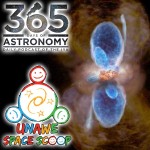Podcaster: Richard Drumm
 Title: Space Scoop: A Tantrum Gives Away Baby Stars Playing Hide & Seek
Title: Space Scoop: A Tantrum Gives Away Baby Stars Playing Hide & Seek
Organization: 365 Days Of Astronomy
Link : astrosphere.org ; http://unawe.org/kids/unawe1501/
Description: Space scoop, news for children.
Bio: Richard Drumm is President of the Charlottesville Astronomical Society and President of 3D – Drumm Digital Design, a video production company with clients such as Kodak, Xerox and GlaxoSmithKline Pharmaceuticals. He was an observer with the UVa Parallax Program at McCormick Observatory in 1981 & 1982. He has found that his greatest passion in life is public outreach astronomy and he pursues it at every opportunity.
Today’s sponsor: This episode of “365 Days of Astronomy” is sponsored by — no one. We still need sponsors for many days in 2015, so please consider sponsoring a day or two. Just click on the “Donate” button on the lower left side of this webpage, or contact us at signup@365daysofastronomy.org.
Transcript:
This is 365 Days of Astronomy. Today we bring you a new episode in our Space Scoop series. This show is produced in collaboration with Universe Awareness, a program that strives to inspire every child with our wonderful cosmos.
Today’s story is…
A Tantrum Gives Away Baby Stars Playing Hide & Seek
Each one of the tiny lights twinkling in the night sky is a gigantic burning star. Well, not burning like we know it here in our oxygen-containing atmosphere. Stars are actually fusing hydrogen atoms into helium, which produces heat like burning things does, so we astronomers will sometimes say burning even though it isn’t.
Don’t you judge me!
Anyway, like people, these stars come in different colours and sizes. Some are 10 times smaller than the Sun; others can be 300 times more massive!
One of the most intriguing questions about the Universe that still needs answering is how such a wide variety of stars are born. The mere existence of massive stars is particularly mysterious, and kinda difficult to study. They evolve very quickly, so there aren’t many out there in the galaxy for us to study.
Another problem with studying the birth of massive stars is their distance from the Earth. There are many star nurseries near to Earth (near in astronomical terms, anyway!), but they are all churning out fairly small stars, like red dwarves called M dwarves… The closest star nursery that’s making massive stars is 1500 light years away.
This means that we need very powerful telescopes to peer into distant star forming clouds to be able to study the birth of massive stars. Powerful telescopes like the ALMA radio telescope array in Chile. ALMA’s radio wavelength sensitivity is perfect for peering through the dusty gas clouds surrounding newly born stars.
The picture in the album artwork for today’s program shows a nursery for massive stars that is currently being studied by astronomers from Japan’s Ibaraki University using ALMA. It’s called IRAS 16547-4247. They’ve just discovered that the orange, peanut-shaped gas cloud in the middle contains not one, but two enormous baby stars!
Altogether, there is enough gas in this system to create over 1000 suns. All this gas is hiding the baby stars, and makes it very difficult to see the two stars directly. Astronomers only know they exist because they are acting just like human babies and throwing a tantrum!
The blue clouds on this picture are jets of gas being thrown into out of the central cloud by the two stars. Like babies throwing their toys from a pram. The diffuse clouds outside the blue jets are the result of jets that were thrown off thousands of years ago. The babies have been at this for a long time!
The blue jets are at least partially made of methanol, or wood alcohol, kinda nasty stuff, toxic in fact. Good thing that the babies are throwing that away!
Hey, Here’s a Cool Fact
It takes around 100,000 years to give birth to a massive star. That might sound like a long time, but it’s 10 times faster than the birth of less massive stars!
Thank you for listening to 365 Days of Astronomy!
End of podcast:
365 Days of Astronomy
=====================
The 365 Days of Astronomy Podcast is produced by NUCLIO. Audio post-production by Richard Drumm. Bandwidth donated by libsyn.com and wizzard media. You may reproduce and distribute this audio for non-commercial purposes. Please consider supporting the podcast with a few dollars (or Euros!). Visit us on the web at 365DaysOfAstronomy.org or email us at info@365DaysOfAstronomy.org. This year we celebrate cosmic light as light is our info messenger in the universe. Join us and share your story to celebrate the International Year of Light. Until tomorrow! Goodbye!

